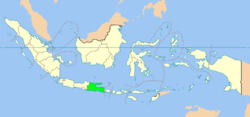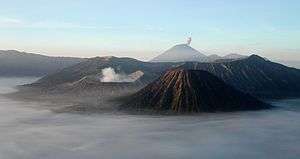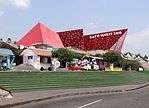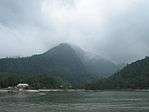East Java
| East Java Jawa Timur Jåwå Wétan ꧋ꦗꦮꦮꦺꦠꦤ꧀ | ||||||
|---|---|---|---|---|---|---|
| Province | ||||||
Clockwise, from top left : Mount Bromo, Lake Sarangan, Bande Alit beach, Batu Secret Zoo | ||||||
| ||||||
|
Motto: Jer Basuki Mawa Béya (Javanese) (meaning: Sacrifices are needed to gain a greatness) | ||||||
 Location of East Java in Indonesia | ||||||
| Coordinates: 7°16′S 112°45′E / 7.267°S 112.750°ECoordinates: 7°16′S 112°45′E / 7.267°S 112.750°E | ||||||
| Country |
| |||||
| Capital |
| |||||
| Government | ||||||
| • Governor | Soekarwo | |||||
| • Vice Governor | Saifullah Yusuf | |||||
| Area | ||||||
| • Total | 47,799.75 km2 (18,455.59 sq mi) | |||||
| Population (2014)[1] | ||||||
| • Total | 38,529,481 | |||||
| • Density | 810/km2 (2,100/sq mi) | |||||
| Demographics | ||||||
| • Ethnic groups | Javanese (80%), Madurese (18%), Chinese (2%)[2] | |||||
| • Religion | Islam (96.36%), Christianity (2.4%), Buddhism (0.6%), Hinduism (0.5%), Confucianism (0.1%), Kejawen also practised[3] | |||||
| • Languages | Indonesian (official), Javanese languages (Arekan & Osing), Madurese (regional) | |||||
| Time zone | WIB (UTC+7) | |||||
| Vehicle registration | AE, AG, L, M, N, P, S, W | |||||
| HDI |
| |||||
| HDI rank | 17th (2014) | |||||
| Website | www.jatimprov.go.id | |||||
East Java (Indonesian: Jawa Timur, abbreviated as Jatim, Javanese: Jåwå Wétan)[4] is a province of Indonesia. Located in eastern Java, it includes the islands of Madura, which is connected to Java by the longest bridge in Indonesia, Suramadu Bridge, as well as the Kangean and Masalembu archipelagos located further east and north, respectively. Its capital is Surabaya, the second largest city in Indonesia and a major industrial center. Banyuwangi is the largest regency in East java and also in Java Island
It covers an area of 47,800 km2, According to the 2010 Census estimates, there were 37,476,757 people residing in the East Java, making it Indonesia's second-most-populous province; the latest official estimates (for January 2014) is 38,529,481.
It has a land border only with the province of Central Java to the west; Java Sea and Indian Ocean border its northern and southern coasts, respectively, while the narrow Bali Strait to the east separates Java from Bali.
History
The history of East Java was substantially of the Majapahit Kingdom - which reached its golden age under Hayam Wuruk in 1350–1389. However, after his death, Majapahit was ruined by other kingdoms.
Following the European occupation, the kingdom was replaced by the Residency system. There were eight Residencies within East Java: Bojonegoro, Madiun, Kediri, Malang, Surabaya, Probolinggo, Besuki and Madura.
In November 1947, a State of East Java was formed under Dutch auspices as part of the United States of Indonesia. After the Dutch-Indonesian Round Table Conference, many people demanded that the state of East Java should be dissolved and become a part of the Republic of Indonesia.
Administrative divisions
- See also: Subdivisions of Indonesia and Districts of East Java
East Java is divided into 29 kabupaten (or regencies), and 9 kotamadya (or cities). This list of regions with their areas and populations at the 2000 and 2010[5] and at the latest (January 2014) census estimates:
| Name | Capital | Area (km²) | Population 2000 Census | Population 2010 Census | Population 2014 estimate |
|---|---|---|---|---|---|
| Mojokerto City | 16.47 | 108,938 | 120,196 | 123,572 | |
| Pasuruan City | 35.29 | 168,323 | 186,262 | 191,494 | |
| Surabaya City | 350.54 | 2,599,796 | 2,765,487 | 2,843,144 | |
| Gresik Regency (includes Bawean Island) | Gresik | 1,191.25 | 1,005,445 | 1,177,042 | 1,210,105 |
| Lamongan Regency | Lamongan | 1,782.05 | 1,181,660 | 1,179,059 | 1,212,179 |
| Mojokerto Regency | Mojosari | 717.83 | 908,004 | 1,025,443 | 1,054,248 |
| Pasuruan Regency | Bangil | 1,474.02 | 1,366,605 | 1,512,468 | 1,554,956 |
| Sidoarjo Regency | Sidoarjo | 634.38 | 1,563,015 | 1,941,497 | 1,996,034 |
| Surabaya Sub-regional Totals | 6,201.83 | 8,901,786 | 9,907,454 | 10,185,732 | |
| Madiun City | 33.92 | 163,956 | 170,964 | 175,767 | |
| Bojonegoro Regency | Bojonegoro | 2,198.79 | 1,165,401 | 1,209,973 | 1,243,961 |
| Jombang Regency | Jombang | 1,115.09 | 1,126,930 | 1,202,407 | 1,236,184 |
| Madiun Regency | Mejayan | 1,037.58 | 639,825 | 662,278 | 680,881 |
| Magetan Regency | Magetan | 688.84 | 615,254 | 620,442 | 637,872 |
| Nganjuk Regency | Nganjuk | 1,224.25 | 973,472 | 1,017,030 | 1,045,598 |
| Ngawi Regency | Ngawi | 1,295.98 | 813,228 | 817,765 | 840,736 |
| Tuban Regency | Tuban | 1,834.15 | 1,051,999 | 1,118,464 | 1,149,882 |
| Northwest Sub-regional Totals | 9,428.60 | 6,550,065 | 6,819,323 | 7,010,881 | |
| Probolinggo City | 56.67 | 191,522 | 217,062 | 223,159 | |
| Banyuwangi Regency | Banyuwangi | 5,782.40 | 1,488,791 | 1,556,078 | 1,599,788 |
| Bondowoso Regency | Bondowoso | 1,525.97 | 688,651 | 736,772 | 757,468 |
| Jember Regency | Jember | 3,092.34 | 2,187,657 | 2,332,726 | 2,398,252 |
| Lumajang Regency | Lumajang | 1,790.90 | 965,192 | 1,006,458 | 1,034,730 |
| Probolinggo Regency | Kraksaan | 1,696.21 | 1,004,967 | 1,096,244 | 1,127,041 |
| Situbondo Regency | Situbondo | 1,669.87 | 603,705 | 647,619 | 665,818 |
| Far Southeast Sub-regional Totals | 15,614.36 | 7,130,485 | 7,592,959 | 7,806,256 | |
| Batu City | 136.74 | (included in Malang Regency) | 190,184 | 195,526 | |
| Blitar City | 32.57 | 119,372 | 131,968 | 135,675 | |
| Kediri City | 63.40 | 244,519 | 268,507 | 276,051 | |
| Malang City | 145.28 | 756,982 | 820,243 | 843,284 | |
| Blitar Regency | Kanigoro | 1,336.48 | 1,064,643 | 1,116,639 | 1,148,005 |
| Kediri Regency | Ngasem | 1,386.05 | 1,408,353 | 1,499,768 | 1,541,897 |
| Malang Regency | Kepanjen | 3,530.65 | 2,412,570 | 2,446,218 | 2,514,932 |
| Pacitan Regency | Pacitan | 1,389.92 | 525,758 | 540,881 | 556,074 |
| Ponorogo Regency | Ponorogo | 1,305.70 | 841,449 | 855,281 | 879,306 |
| Trenggalek Regency | Trenggalek | 1,147.22 | 649,883 | 674,411 | 693,355 |
| Tulungagung Regency | Tulungagung | 1,055.65 | 929,833 | 990,158 | 1,017,972 |
| Southern Sub-regional Totals | 11,529.66 | 8,953,362 | 9,534,258 | 9,802,077 | |
| East Java (excluding Madura) Totals | 42,774.45 | 31,535,693 | 33,853,994 | 34,804,946 | |
| Bangkalan Regency | Bangkalan | 1,001.44 | 805,048 | 906,761 | 932,232 |
| Pamekasan Regency | Pamekasan | 792.24 | 689,225 | 795,918 | 818,283 |
| Sampang Regency | Sampang | 1,233.08 | 750,046 | 877,772 | 902,429 |
| Sumenep Regency | Sumenep | 1,998.54 | 985,981 | 1,042,312 | 1,071,591 |
| Madura Totals | 5,025.30 | 3,230,300 | 3,622,763 | 3,724,535 | |
| Total for Province | 47,799.75 | 34,765,993 | 37,476,757 | 38,529,481 | |
Demography
| Historical population | ||
|---|---|---|
| Year | Pop. | ±% |
| 1971 | 25,516,999 | — |
| 1980 | 29,188,852 | +14.4% |
| 1990 | 32,503,991 | +11.4% |
| 1995 | 33,844,002 | +4.1% |
| 2000 | 34,783,640 | +2.8% |
| 2010 | 37,476,757 | +7.7% |
| 2014 | 38,529,481 | +2.8% |
| Source: Badan Pusat Statistik 2010, 2014 Health Ministry[1] | ||
According to the 2000 census, East Java had 34,765,993 people, which increased to 37,476,757 people at the 2010 Census,[6] making it the second most populous Indonesian province after West Java. Akin to Central Java, the region's birth rates are not necessarily any lower than the rest of Java, however due to net population outflows, especially in times of calamity, not limited to volcanic eruptions or droughts, the region has varying rates of population growth that are generally lower than national average. Ethnic Javanese dominate the Java mainland as well as the total population of the province overall, while ethnic Madurese inhabit Madura and the Kangean and Masalembu archipelagos, though centuries of migrations have led the Java mainland to have a larger proportion of Madurese people than Madura itself. Minorities include distinct Javanese ethnicities such as the Tengger people in Bromo, the Samin and the Osing people in Banyuwangi. East Java also hosts a significant population of foreign ethnic groups, such as Chinese, Indians, and Arabs.
Languages
Besides the formal language, Indonesian, East Java people use Javanese as daily language. Javanese as spoken in the western part of East Java (Kulonan) is a similar dialect to the one spoken in Central Java, with its hierarchy of high, medium, and low registers. In the eastern part, such as Surabaya, Malang, and others, a more egalitarian version of Javanese is spoken, with less regard of hierarchy and a richer vocabulary for vulgarity. The dialect is notable for its roughness compared to other dialects spoken elsewhere in Java (especially the Mataram dialect spoken around Surakarta and Yogyakarta, which is renowned for its smoothness) and contributes to the stereotype among Javanese people of East Javanese being "blunt" and "loud". Variants of Javanese are also used by Osing and Tengger minorities, the former utilizing a Balinese-influenced Javanese by virtue of its closeness with Bali island, and the latter speaking an archaic form of the language that retains many features now lost in other more-innovative Javanese dialects.
Other than Javanese, minority language includes Madurese, spoken by around 15 million ethnic Madurese people inhabiting Madura and the Kangean and Masalembu Islands. Though they live practically next door with the Javanese, the language is actually more closer genetically to Balinese, Malay, and Sundanese.
Religion
A long time ago, Hinduism and Buddhism dominated the island until Islam gradually supplanted Hinduism in the 14th and 15th century. The last nobles and people of the fallen Majapahit fled to Bali. Islam spread from northern cities in Java where many Muslim traders from Gujarat, India stopped by. The eastern part of East Java, from Surabaya to Pasuruan, and the cities along the coast, and back to Banyuwangi to Jember, are known as the eastern salient, or "Kawasan Tapal Kuda" (The Horseshoe region).
A remnant of Hindu tradition and syncretic abangan is exist because of Islamic and Hinduism acculturation in Java.
Natural resources
- Chalk (Trenggalek & Gresik)
- Cement (Gresik)
- Marble (Tulungagung)
- Petroleum (Bojonegoro)
- Salt (Madura Island)
- Kaolinite (Blitar)
- Sulfur (Banyuwangi)
- Gold (Banyuwangi)
Seaports
East Java has a famous seaport Tanjung Perak, Surabaya. in 2013, the government planned to build 4 seaports: in Lamongan, Gresik, Tanjung Tembaga in Probolinggo and Tanjung Wangi in Banyuwangi.[7]
Education
East Java hosts famous universities in Indonesia, both owned by government and private. Three major cities for universities are Surabaya, Malang, and Jember; there is also a university at Bangkalan on Madura island. Among them, University of Airlangga and Institut Teknologi Sepuluh Nopember are the most famous of the province's universities, and both are located in Surabaya.
Another important form of education that is available in most cities in East Java is the pesantren. This is a kind of socio-education organized by Islamic clerics, and associated with local or national Muslim organizations. Jombang is a famous region for its pesantren.
Media
East Java supports several regional media outlets. Local newspapers with provincial news reach their readers earlier than their competitors from Jakarta. In the spirit of "providing more news from around readers", most newspapers even issue municipal sections which are different among their distribution areas.
- Jawa Pos Group, one of the major newspaper groups in Indonesia, based in Surabaya.
- Surya, is a newspaper based in Surabaya. (owned by Kompas Group).
National parks

- Meru Betiri National Park - Between Jember and Banyuwangi districts, this park covers 580 km2 (224 sq mi). Hard to get to, it contains fantastic coastal rainforest and scenery and is home to abundant wildlife.
- Alas Purwo National Park - This 434 km2 (168 sq mi) park is formed by the Blambangan Peninsula (southeastern Java). Comprising mangrove, savanna, lowland monsoon forests and excellent beaches, the park's name means First Forest in Javanese. Javanese legend says that the earth first emerged from the ocean here.
- Baluran National Park - This 250 km2 (97 sq mi) national park is located in northeastern Java, known as The Little Africa, formerly extensive savanna has been largely replaced by Acacia.
- Bromo Tengger Semeru National Park - Located in East Java at the region of Probolinggo and Pasuruan, 70 km (43 mi) from Surabaya the capital city of East Java province. Mount Bromo is one of the great hiking and trekking destinations for overseas tourists. The scenic view of Bromo also attracts hundreds of photo enthusiasts to see the views there.
Local economic governance
Based on the survey conducted between August 2010 and January 2011, East Java included 11 of the top 20 cities and regencies of the local economic governance which measures nine parameters: [8]
- infrastructure
- private enterprises development program
- access to land
- interaction between local administrations and businesses
- business licensing
- local taxes and fees
- security and business conflict resolution
- capacity and integrity of regional heads
- quality of local regulations
The top 5 were:
- Blitar, East Java
- North Lampung Regency, Lampung
- Probolinggo, East Java
- Batu, East Java
- Sorong Regency, West Papua
Cuisine

East Java cuisine tends to be hotter than that of Central and West Java. Rujak Soto from Banyuwangi is also famous these days.
References
- 1 2 Estimasi Penduduk Menurut Umur Tunggal Dan Jenis Kelamin 2014 Kementerian Kesehatan
- ↑ Indonesia's Population: Ethnicity and Religion in a Changing Political Landscape. Institute of Southeast Asian Studies. 2003.
- ↑ Keagamaan 2009
- ↑ Piwulang Basa Jawa Pepak, S.B. Pramono, hal 148, 2013
- ↑ Biro Pusat Statistik, Jakarta, 2011.
- ↑
- ↑ "East Java vows to top Jakarta, build four ports by 2013". The Jakarta Post. 2011-06-01. Retrieved 2013-12-10.
- ↑ "Blitar leads economic governance survey". The Jakarta Post. 2011-06-08. Retrieved 2013-12-10.
External links
-
 East Java travel guide from Wikivoyage
East Java travel guide from Wikivoyage - (Indonesian) Official website





